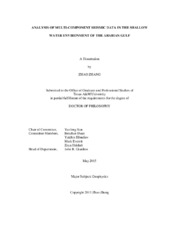| dc.description.abstract | The quality of the seismic data is essential to quantitative reservoir characterization of rock properties and geological structure interpretation. Although marine multi-component seismic data hold a wealth of information about both compressional and shear velocities, the acquisition suffers from high levels of noise, which make the processing a challenging task and drastically decreases optimal value extraction. This dissertation employs a four component (4C) processing workflow via advanced time-frequency-wavenumber filtering and polarization methods to improve data quality for further interpretation and reservoir characterization.
The proposed workflow is used to enhance seismic reflected energy and explore the shear wave information in the horizontal components. This study makes use of one 2D seismic line and well log dataset from one offshore in the southern Arabian Gulf (Abu Dhabi, United Arab Emirates). A combination of strong lateral seafloor heterogeneities, shallow water depths (~10m), and hard sea bottom results in highly interfering and complex wave-fields and seemingly noisy seismic data acquired in this shallow water environment. Meanwhile, we expect converted wave modes (PS-S waves) due to the strong reflector at hard sea bottom. In this work, we first propose sophisticated filtering algorithms to attenuate surface waves, and then designed advanced processing sequence combined with existing techniques for converted waves detection.
Compared to body waves, surface waves are characterized by low velocity, low frequency and high polarization. First, we utilize the variable factor S transform to transform the seismic data from time domain to time-frequency-wavenumber(TFK) domain. This designed transform provides better resolution control on both time and frequency by adjusting the shape of Gaussian window function through additional parameters. Second, we estimate the impacts of residual surface waves on rotation and suppress those waves using TFK dependent polarization analysis. Polarization attributes, ellipticity and rise angle, are calculated through a developed 3D covariance matrix analysis that exploits the joint relationship of wavenumber, time, frequency and polarization. Those computed attributes are used for attenuating the surface waves and determining radial and transverse components. Third, we introduce the new 4C ocean bottom cable (OBC) processing strategy using both compressional and shear waves to recover the image of the subsurface from noisy seismic data.
Comparing the time slices and gathers before and after using the strategy, it is observed that the method, described here, attenuates surface waves and remnant surface waves effectively and improves the signal to noise ratio without weakening the desired reflected signals. The results from this dissertation will find application in reservoir characterization from shear wave and converted wave analysis. | en |


